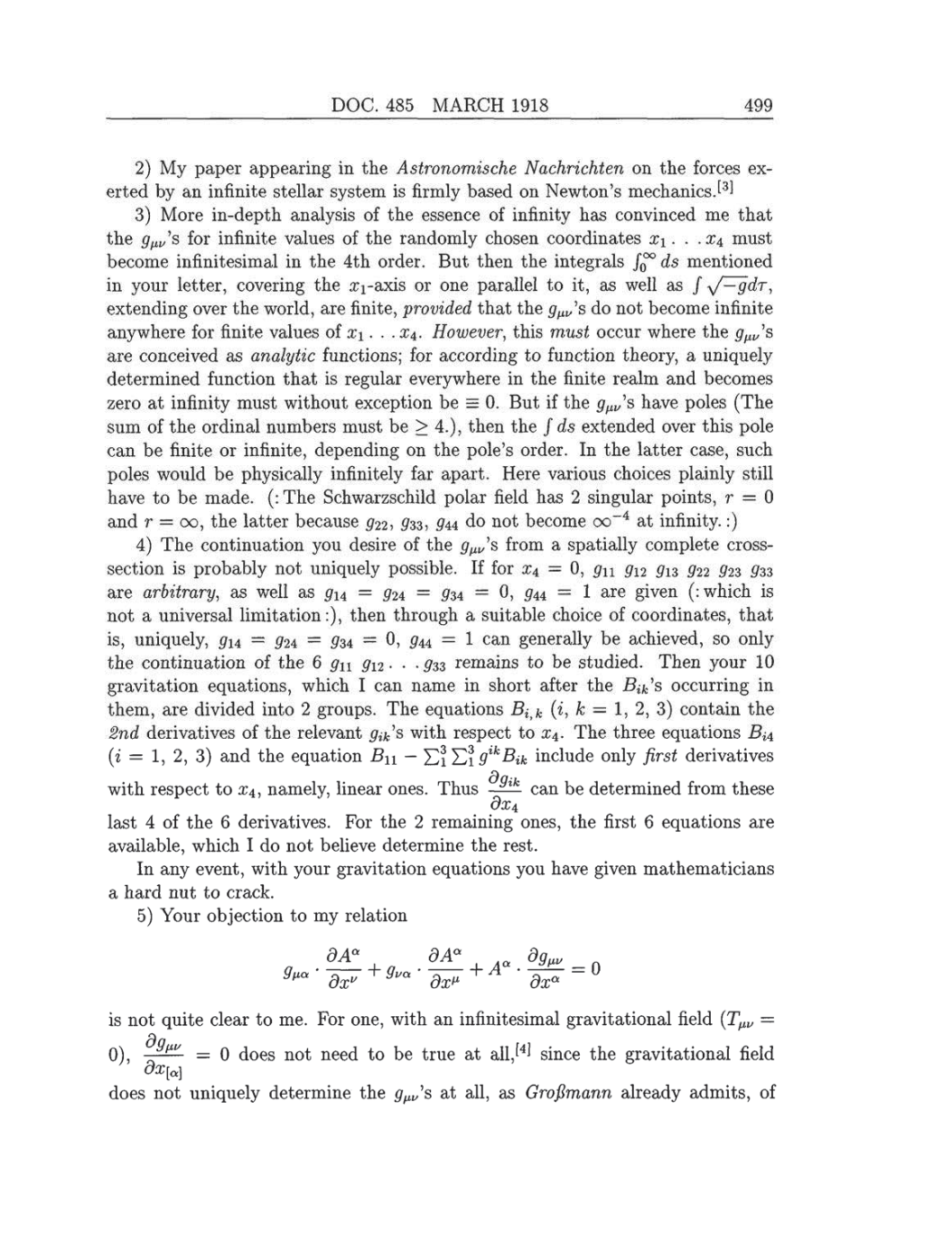DOC.
485
MARCH
1918 499
2)
My paper
appearing
in
the
Astronomische Nachrichten
on
the
forces
ex-
erted
by
an
infinite stellar
system
is
firmly
based
on
Newton’s
mechanics.[3]
3)
More
in-depth
analysis
of
the
essence
of
infinity
has convinced
me
that
the
guv's
for infinite values of
the
randomly
chosen coordinates
x1...x4
must
become infinitesimal
in
the 4th
order.
But then the
integrals
f0°°
ds mentioned
in
your
letter,
covering
the
x1-axis
or one
parallel
to
it,
as
well
as
ƒ
/-gdr,
extending
over
the
world,
are
finite, provided
that
the
guv's
do not become infinite
anywhere
for finite values of
x1...x4.
However,
this must
occur
where
the
guv's
are
conceived
as
analytic
functions;
for
according
to function
theory,
a
uniquely
determined
function
that
is
regular
everywhere
in
the
finite realm and becomes
zero
at
infinity
must
without
exception
be
=
0.
But
if
the
guv's
have
poles
(The
sum
of the ordinal numbers must be
4.),
then the
ƒ
ds extended
over
this
pole
can
be finite
or
infinite, depending
on
the
pole’s
order. In
the latter
case,
such
poles
would be
physically infinitely
far
apart.
Here various
choices
plainly
still
have to be made.
(:The
Schwarzschild
polar
field
has
2 singular points,
r
=
0
and
r
=
00,
the latter
because
g22, g33, g44
do not become oo-4 at
infinity.:)
4)
The continuation
you
desire of
the
guv's
from
a
spatially complete
cross-
section is probably
not
uniquely possible.
If for
x4
=
0,
g11 g12 g13 g22 g23 g33
are
arbitrary,
as
well
as
g14 =
g24
= g34 =
0,
g44
=
1
are
given (:which
is
not
a
universal
limitation:),
then
through
a
suitable
choice
of
coordinates,
that
is,
uniquely,
g14
=
g24
=
g34
=
0,
g44 =
1 can
generally
be
achieved,
so only
the continuation
of
the
6
g11
g12
...
g33
remains
to
be studied. Then
your
10
gravitation equations,
which
I
can name
in short after
the
Bik's
occurring
in
them,
are
divided into
2 groups.
The
equations
Bi,
k
(i,
k
=
1,
2, 3)
contain
the
2nd derivatives of
the
relevant
gik's
with
respect
to
x4.
The three
equations
Bi4
(i
=
1,
2,
3)
and
the
equation
B11
-
X31S31gikBik
include
only
first
derivatives
with
respect
to
x4, namely,
linear
ones.
Thus
dgik/dx4
can
be
determined from these
last
4
of
the
6
derivatives. For the
2 remaining ones,
the
first
6 equations
are
available,
which
I
do not believe determine
the
rest.
In
any
event,
with
your
gravitation equations
you
have
given
mathematicians
a
hard
nut
to crack.
5)
Your
objection
to
my
relation
dAa
dm
‘
qxu
+
9va
+ Aa
.
díh»
=
dx^ dx
is
not
quite
clear to
me.
For
one,
with
an
infinitesimal
gravitational
field
(Tuv =
0),
dguv/dx
=
0
does
not
need to be true
at
all,[4]
since
the
gravitational field
does not
uniquely
determine
the
guv's
at
all, as
Großmann already
admits,
of
